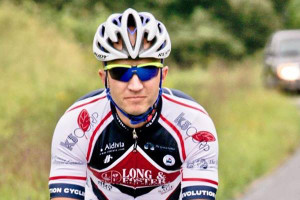Michal believes that you can take an active role in how poor genetics impact life quality.

Genetics can be good. When people see my father’s artwork the inevitable question that arises is, “Do you have of any of your dad’s talent?” When I respond that all three of his children could draw, paint and be generally creative, I would want to add a cautionary caveat that all three of us are also the hereditary recipients of congenital heart disease.
Growing up with a heart murmur, I would be reminded on a regular basis by doctors and nurses that while a cardiac abnormality, there was nothing to be concerned about, save for the requisite antibiotic prior to any dental work. Rare was the case when Mitral Valve Prolapse developed into a condition that required something as invasive as open-heart surgery.
So benign was a heart murmur, I thought, that when my primary care physician told me in the spring of 2008 that she wanted an echocardiogram performed, I didn’t even give it a second thought. Her concern must be connected to me not having been in for a physical in years, along with turning 40 recently I reassured myself.
This casual attitude carried over to when my cardiologist wanted to meet with me immediately following the test. “Your echocardiogram wasn’t exactly normal,” he said. “You have Mitral Valve Prolapse.” A wave of relief came over me as I realized he was telling me something that I had known for the almost 40 plus years of my life. “Thanks, Doc,” I said in an almost ‘I got this’ tone. “We’re going to need to fix it soon before it gets worse,” he continued. ‘Fix’ I asked? “Yes. You will need open-heart surgery.”
At odds with the fresh diagnosis of severe Mitral Valve Regurgitation was that I was displaying absolutely none of the common symptoms such as shortness of breath, fatigue, heart palpitations or swollen ankles and feet. In fact, I was still racing my bicycle. A subsequent stress test indicated that while the regurgitation was severe enough to warrant surgery, there was no apparent damage to the heart. Rather than sit around for the inevitable negative outcome of “watchful waiting” I decided with my doctors’ consent to take action immediately.
It was time to get better educated. I learned as much as I could about my condition and about the surgery itself. I interviewed cardiothoracic surgeons and toured facilities, ultimately choosing Dr. Paul Massimiano and INOVA Fairfax Hospital. Dr. Massimiano was confident that he could repair the faulty valve without resorting to a replacement. And instead of cracking open the chest, Dr. Massimiano and his team would employ a minimally invasive procedure that would reduce post-operative issues and quicken recovery.
Given that the regurgitation was not negatively impacting my fitness, I decided to “train” for the surgery; aggressively riding my bike up until the day before I went into the hospital. One thing that Dr. Massimiano mentioned during the pre-op visits that resonated was that there was a correlation between a patient’s health (including fitness) and recovery time.
I walked into the hospital that November morning in the best shape of my life. I walked out of the hospital a little more than 24 hours later convinced that getting in better shape was one of the keys to a very successful outcome.
If there was an unknown following the procedure it was whether I could get back to the level of fitness and enjoyment of endurance sports that came about prior to be wheeled into the operating room. One day I came upon the inspiring story of David Watkins and the Ironheart Racing Team. Seeing fellow cardiac athletes and weekend warriors who returned to the sports they loved prior to open-heart surgery and were achieving remarkable results post-op enabled me to return the bike with a renewed passion to make a difference.
My shorter-than-average hospital stay and rapid recovery were due in part to being physically active. Following the successful outcome of the surgery I have become an even more fervent movement evangelist. My ultimate goal is work with the Ironheart Foundation to bring greater awareness to the benefits of cardiovascular fitness both as preventative and rehabilitative in the cardiac athlete’s lifecycle.
While you cannot outrun poor family genetics when it comes to heart disease, you can take an active role in how it impacts your quality of life.
– Michal Gnatek, Leesburg, Virginia
